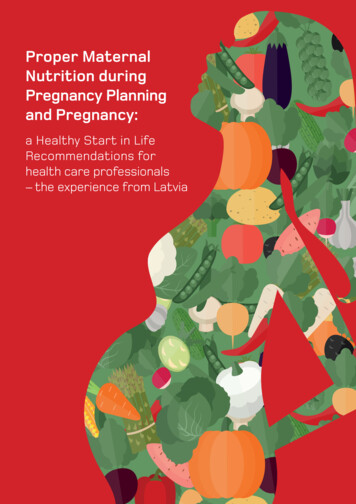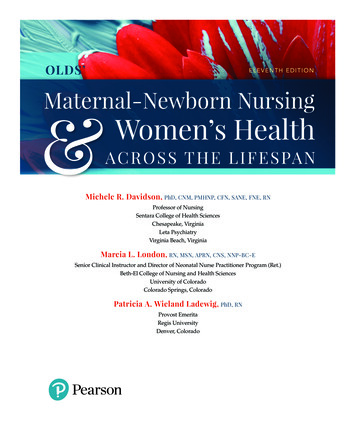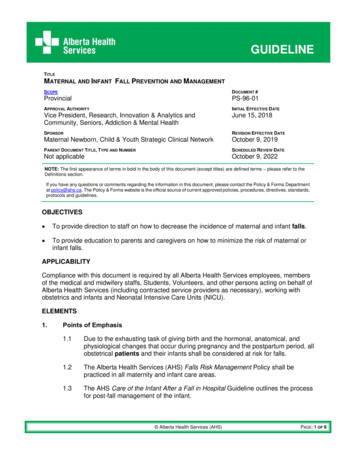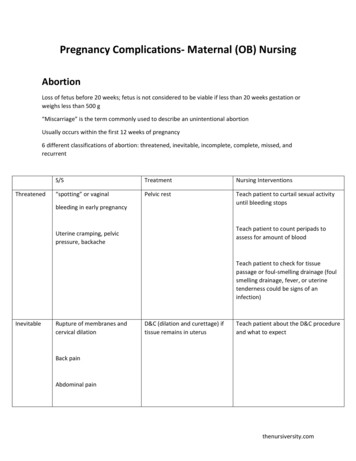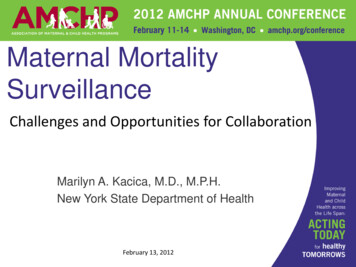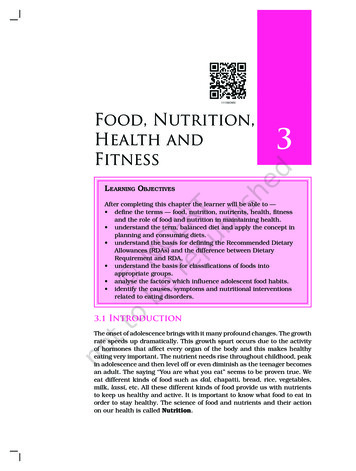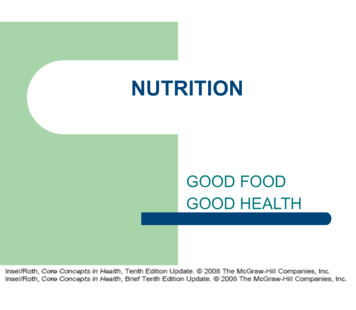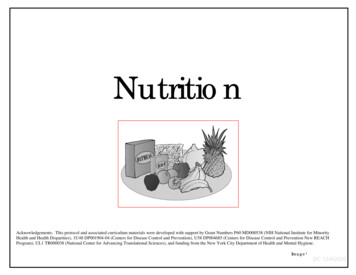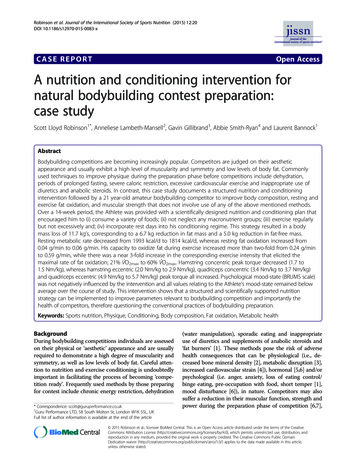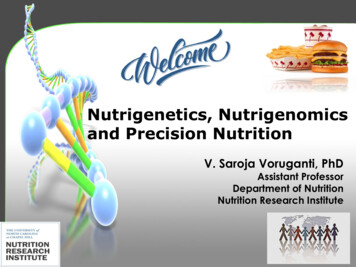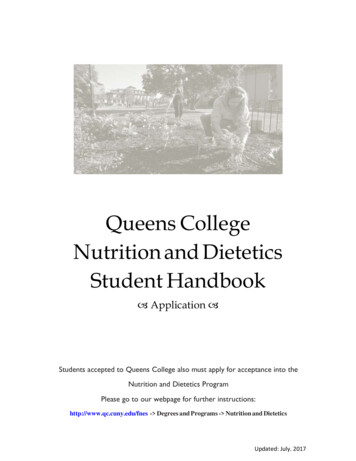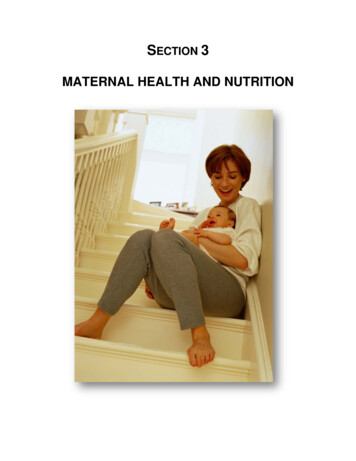
Transcription
SECTION 3MATERNAL HEALTH AND NUTRITION
TABLE OF CONTENTS3.03.13.23.33.4Maternal Nutrition3.0.1 Introduction3.0.2 Purpose3.0.3 ObjectivesPregnancy3.1.1 Signs of Pregnancy3.1.2 Prenatal Care3.1.3 Stages of PregnancyChanges During Pregnancy3.2.1 Breast Changes3.2.2 Swelling3.2.3 Mouth and Tooth Changes3.2.4 Heartburn and Indigestion3.2.5 Nausea and Vomiting3.2.6 Constipation and Gas3.2.7 HemorrhoidsPrenatal Nutrition3.3.1 Prenatal Diet3.3.2 Nutrient Needs During Pregnancy3.3.3 SupplementationSpecial Health Concerns During Pregnancy3.4.1 Diabetes3.4.2 Hypertension and Preeclampsia3.4.3 Overweight and Underweight3.5Special Dietary Concerns During Pregnancy3.5.1 Adolescence3.5.2 Pica and Unusual Cravings3.5.3 Special Diets3.5.4 Food Safety3.6Prenatal Weight Gain3.6.1 Recommendations3.6.2 High Maternal Weight Gain3.6.3 Low Maternal Weight Gain3.6.4 Where Does The Weight Go?3.6.5 ExerciseLifestyle Risks During Pregnancy3.7.1 Smoking3.7.2 Alcohol3.7.3 Caffeine3.7.4 Drugs3.73.8Postpartum Care3.8.1 Postpartum Sadness and Depression3.8.2 Postpartum Nutrition3.8.3 Weight Control3.8.4 Dietary Supplements
3.93.8.5 Routine HealthcareSelf-Test Questions3.10References3.11Resources
3.0 MATERNAL NUTRITION3.0.1 IntroductionA mother’s nutrition status and health both before and during pregnancy havesignificant effects on the outcome of her offspring. A baby's birth weight, rate ofpostnatal growth and chances of survival are all influenced by the mother’shealth and dietary intake. Good nutritional status before, during and afterpregnancy optimizes maternal health and reduces the risk of pregnancycomplications, birth defects and chronic disease in her children in lateradulthood. A healthy, well-nourished woman is more likely to have a healthypregnancy, which increases her chances of having a healthy baby. A healthybaby has a better chance of growing into a healthy child and then growing into ahealthy adult.In this module you will learn about the special nutrition concerns and needs forprenatal, breastfeeding and non-breastfeeding postpartum women.3.0.2 PurposeThe purpose of the Maternal Health andNutrition Section is to provide information onthe stages of fetal development and basicnutrition concepts pertinent to pregnant andpostpartum WIC participants.3.0.3 ObjectivesUpon completion of Section 3, you will be ableto:1. Identify the stages of pregnancy andvulnerable periods of fetal development.2. State several physiological adjustmentsduring pregnancy.3. State the recommended ranges ofmaternal weight gain during pregnancy.4. Specify gestational nutrient needs and nutrition-related concerns.5. Identify counseling recommendations for common pregnancy-relatedproblems such as nausea, edema, heartburn, hemorrhoids andconstipation.6. Identify the risks and counseling recommendations for use of caffeine,alcohol, drugs and tobacco during pregnancy.7. Compare a woman’s nutritional needs as she transitions from pregnancyto lactation.
3.1 PREGNANCY3.1.1 Signs of PregnancyPregnancy is an exciting time of major change. Pregnancy symptoms differ fromwoman to woman and pregnancy to pregnancy; however, one of the mostsignificant pregnancy indicators is a delayed or missed menstrual cycle. Somewomen experience signs or symptoms of pregnancy within a week of conception.Other women may develop symptoms over a few weeks or may not develop anysymptoms at all.Some of the most common pregnancy signs and symptoms include: Spotting or a very light menstrual period Nausea or queasiness Tender or swollen breasts Frequent urination Feeling very tired Being moody Feeling bloatedSymptoms listed above are normal for pregnancy, however, some symptomsmay not be normal and could be indicators of early pregnancy loss or ectopicpregnancy—a pregnancy that occurs outside the uterus.A medical intervention may be needed if potential pregnancy is suspected and awoman presents with any of the following signs: Cramps or severe abdominal pain Spotting that lasts more than one day Vaginal bleeding Faintness or dizziness3.1.2 Prenatal CarePrenatal care is the health care women receive duringpregnancy. A pregnant woman needs prenatal care.Prenatal care is important to keep the mother and herbaby healthy. Babies of mothers who do not receiveprenatal care are three times more likely to be born with alow birth weight and five times more likely to die thanthose born to mothers receiving care. When health careproviders see mothers regularly they can detect and treathealth problems early, which can minimize many existingproblems and prevent others. Further, prenatal care canprovide opportunities to encourage women to adopt goodhealth and eating habits, get emotional counseling orsupport if needed, find out about local family services andprepare for childbirth as well as being a parent.
The woman’s health and well being will be closely monitored by a health careteam that may include the doctor, nurse, WIC Nutritionist and others. Multipletests and exams will be completed to check on the health of her baby. Allwomen should be encouraged to ask their health care provider for advice oncoping with common changes during pregnancy and collect the information theywill need to make important choices.3.1.3 Stages of PregnancyA typical pregnancy lasts for 280 days, or 40 weeks counting from the first day ofthe last menstrual period (LMP). The estimated date of confinement (EDC) ofthe infant is estimated from the LMP date. A sonogram and other measurementstaken by the health care provider more accurately predict the EDC. An infantwho is born at 38 to 40 weeks gestation is considered to be full term. Theaverage pregnancy lasts for about 40 weeks and is divided into three trimesters.Each trimester is about 13-14 weeks or about 3 months.Fetal Development by TrimesterThe First Trimester: 0-13 Weeks The placenta develops Major organs and nervous system form Heart starts beating Lungs begin to develop Bones develop Head, face, eyes, ears, arms, fingers, legs and toes form Hair starts to grow Buds for 20 temporary teeth developThe Second Trimester: 14-28 Weeks The organs develop further and begin to function Eyebrows, eyelashes, and fingernails form Skin is wrinkled and covered with a waxy coating Genitals develop Fine hair (lanugo) covers the body The fetus moves, sleeps, and wakes The fetus can swallow, hear, pass urine, and suck his/her thumbThe Third Trimester: 29-40 Weeks The fetus kicks and stretches Lanugo disappears With major development finished, the fetus gains most of its weight Bones harden, but the skull remains soft and flexible for deliverySource: The American College of Obstetricians and Gynecologists. (2005). Your Pregnancyand Birth (4th ed.). Washington, DC: Meredith Books.
3.2 Changes During Pregnancy3.2.1 Breast ChangesFor many women the first hint of being pregnant is the breast changes theyexperience. Women may notice an increase in breast size and some tendernessvery early even before the pregnancy is confirmed. Breasts may grow a wholebra-cup size by the sixth week of the pregnancy. Breast growth is a positive signthat the breasts are preparing for breastfeeding.Changes that take place in the breast include: An increase in the number of milk glands as the body prepares for makingmilk. Fat accumulates. Bluish veins may appear as blood flow to breasts increases. The nipples and areola darken. Nipples may stick out more and theareolas grow larger. Montgomery’s tubercles, small glands on the surface of the areola,become raised and bumpy. These glands produce an oily substance thatkeeps the nipples and areolas soft.Breasts may continue to grow in size and weight during the first three months ofpregnancy. During the third month of pregnancy the first colostrum appears.Colostrum is the thick yellow, nutrient and immune component-rich milk thebreast produces for the baby's first few days of life. Some women may noticeslight drainage of colostrum from their nipples. In the last trimester the breastcontinues to expand from the enlargement of milk-making cells and engorgementwith colostrum.3.2.2 SwellingMost pregnant women experience some edema or swelling in the hands, face,legs, ankles and/or feet. Edema which is caused by extra fluid in the body mayworsen in late pregnancy and during the summer months.To relief swelling: Avoid prolonged standing. Elevate feet. You may try to sleep with legs propped up on pillows. Thiskeeps fluid from building up in the lower half of the body. Be physically active as exercise can improve circulation, which reducesedema. Avoid garters, socks or stockings that constrict the leg.3.2.3 Mouth and Tooth ChangesDuring pregnancy gums and teeth are more vulnerable to cavities and gumdisease. Pregnancy hormones can make gums swell and bleed. A dental checkup early in pregnancy is important to ensure that the mouth stays healthy.Putting off dental work can lead to more dental problems. When scheduling a
dental appointment it is important that the woman lets her dentist know about thepregnancy. It is the role of certifying WIC staff to find out if a woman has anydental issues and provide appropriate dental referrals when needed.Questions to askPossible dental risk conditionsHave you visited a dentist within the past12 months?There is diagnosis of dental problems by adentist, physician or a health care providerworking under the orders of a physician.Do you have tooth decay, broken teeth,bleeding gums, gum infection, (periodontaldisease), missing teeth and/or misplacedteeth that make chewing difficult?Periodontal disease (gum infection) isevidenced by swollen, red, bleeding andinflamed gums.Do you (or your child) avoid certain foodsthat you would otherwise eat, or choosesofter foods, because of chewingproblems?Tooth decay, broken teeth, gum infection(periodontal disease), tooth loss and/orineffectively replaced teeth that impair theability to chew food in adequate quantity orquality.Do your gums feel swollen, sensitive,bleed easily or have a reddenedappearance?Gingivitis is present in pregnant women.Source: MO WIC Operations Manual. 2010 ER# 2.039003.2.4 Heartburn and IndigestionOften the words “heartburn” and “indigestion” are used interchangeably howeverthey are not the same condition. Indigestion happens when the stomach takeshours to empty. Indigestion symptoms include: feeling full, bloated and gassy.Heartburn is a burning feeling in the throat and chest. Pregnancy hormones,which relax the muscle valve between the stomach and esophagus are often thecause of heartburn during pregnancy. When the valve does not close, stomachacids leak into the esophagus. As the baby grows, it may press up against thestomach and cause stomach acid to leak into the esophagus.Tips to help relieve or prevent indigestion and heartburn are: Eat five or six small meals per day instead of two or three big ones. Eat slowly and chew food well. Limit liquids with meals. Sit upright for at least one hour after a meal. Limit greasy, fried and fatty foods. Limit caffeinated and carbonated drinks, citrus fruits and juices. Do not eat or drink shortly before bedtime or napping. Wear clothes that are loose around the waist.
3.2.5 Nausea and VomitingNausea and vomiting are common during pregnancy. This is often called“morning sickness” although it can occur at any time of the day. Most womenwho experience morning sickness notice a dramatic improvement after the firsttrimester but some women have nausea and vomiting throughout pregnancy.Morning sickness may be more severe with first-time pregnancies or multi-fetalpregnancies. Most mild cases of nausea and vomiting are not harmful to themother or the baby. Morning sickness does not mean the baby is sick.Some tips that may be helpful in relieving nausea and vomiting are: Before getting out of bed in the morning, sit on the side of the bed for afew minutes and then get up slowly. You may also try eating a cracker ordry piece of toast before getting up. Get plenty of fresh air. Eat five or six small meals each dayinstead of three big ones and do notlet the stomach get empty. Sit upright after meals. Avoid strong smells. Avoid greasy, rich, fatty and/orspicy foods instead eat low fat,easy to digest foods such as: plainpasta, crackers, potatoes, rice,fruits and vegetables, lean meats,fish, poultry and eggs. Drinking ginger ale or pepperminttea may help relieve thesesymptoms for some women.Frequent vomiting during the day may make it more difficult to keep adequatefluids. This is a health concern for the mother and her baby. Medical attentionmay be necessary if liquids have not been kept down for more than one day.Medical intervention may also be needed if the mother has vomited blood, hashad a more than 2 pound weight loss, and/or vomits more than four times in oneday. Severe morning sickness, also known as hyperemesis gravidarum, mayrequire a hospital stay for treatment with intravenous fluids and medications.3.2.6 Constipation and GasMost pregnant women experience constipation during the course of theirpregnancy for several reasons, including: Hormone changes. Increased levels of the hormone progesterone duringpregnancy slow the digestive process. Iron supplements. Often prescribed to prevent anemia in pregnancy, maymake constipation worse. Changes in digestion. The colon absorbs more water during pregnancyso less water is available for stool formation which results in harder stool.
Toward the end of pregnancy, the weight of the uterus puts pressure onthe rectum.When this occurs, gas can build up in the abdomen and cause bloating and pain. Tips for managing constipation during pregnancy: Drink plenty of liquids—especially water. Eat high-fiber foods. Eat meals at regular times each day. Be physically active every day. Note: Laxatives are not recommendedduring pregnancy.3.2.7 HemorrhoidsConstipation during pregnancy can lead to hemorrhoids. Hemorrhoids areswollen blood vessels in and around the anus. These vessels are normallypresent but stretch under pressure. The two main causes of the swelling are theextra blood in the pelvic area and the pressure the growing uterus puts on veinsin the lower body. The straining during bowel movements caused byconstipation can lead to swollen veins as more blood is being trapped in theveins.To avoid or relief this problem, it is recommended to: Eat high-fiber foods and drink plenty of liquids. Be physically active as standing or sitting for long time can put pressureon the veins in the pelvic area. Keep prenatal weight gain within recommendations. Excess weight canaggravate hemorrhoids. If hemorrhoids have already developed the discomfort can be alleviated bysoaking in a tub few times a day or by applying an ice pack to the problemarea.Fiber-Rich FoodsBreads/CerealsWhole wheat bread, bran breads and cereals,oatmeal, shredded wheat, bran flakes, whole wheat,pita bread, whole wheat pastaGrainsBarley, bulgur, cornmeal, whole grain, oat bran, brownrice, wheat branFruitsApple with skin, dried apricots, dried figs, kiwi fruit,prunes, raisins, raspberries, strawberriesVegetablesBeans, broccoli, brussels sprouts, cabbage, carrots,cauliflower, corn, potatoes (with skin), peas, sweetpotatoes, tomatoes (raw),turnip greensOtherNuts, almonds, coconut, hazelnuts, peanuts
3.3 PRENATAL NUTRITION3.3.1 Prenatal DietGood nutrition is important during pregnancy. A pregnant woman must consumeadequate nutrients and energy for her body functions and to support herdeveloping fetus. A woman’s diet during pregnancy can significantly affect theoutcome of the pregnancy. When a pregnant woman eats, the nutrientsabsorbed travel through her blood stream to the placenta. The nutrients crossthe placenta and are taken up by the blood stream of the fetus.The prenatal diet should include proteins, carbohydrates, vitamins, minerals andfat to fuel the body and help the baby grow. If the maternal diet does not containadequate nutrients to meet the growing fetus needs, the mother will supply someof the nutrients at her own body’s expense. She may not produce a healthyplacenta or make enough blood, causing her infant to grow more slowly.Pregnant women need adequate fluid intake to prevent dehydration which canlead to miscarriage or premature labor. Pregnant women need a minimum of 2quarts (64 oz) of fluids every day. Water should account for at least half of thefluids consumed. The remainder can come from milk, juice and other beverages.Criteria for a Healthy Prenatal Diet Provides adequate calories for appropriate weight gainIs well-balanced and follows MyPlateTastes good and is enjoyable to eatSpaces eating at intervals throughout thedayProvides adequate amounts of high fiberfoodsIncludes 8 cups of fluid dailyLimits beverages that contain caffeine(2-3 servings or fewer daily)Has moderate amounts of fat, saturatedfat, cholesterol, sugar and sodiumStable and continuous food supplyExcludes alcoholSource: Story M, Stang J (eds). (2000). Nutrition and the Pregnant Adolescent: A Practical Reference Guide.Minneapolis, MN: Center for Leadership, Education, and Training in Maternal and Child Nutrition, University of Minnesot3.3.2 Nutrient Needs During PregnancyAll of the nutrients needed to support a healthy pregnancy, except for iron andfolic acid can be obtained from a healthy diet. One way to make sure that allnutrient needs are met is to follow the MyPlate food plan developed by the U.S.Department of Agriculture (USDA). MyPlate gives guidelines to help mothers getthe nutrients they need. For more information visit the MyPlate web page at
http://www.ChooseMyPlate.gov. Section 2 of this manual provides moreinformation for counseling women on choosing foods using MyPlate.During pregnancy higher amounts of certain nutrients are needed to supportgrowth of the fetus and cell differentiation.Dietary Reference Intakes for WomenabNutrientAdult womanPregnancyEnergy (kcal)2,4032,743c, 2,855dProtein (g/kg/d)0.81.1Carbohydrate (g/d)130175Total fiber (g/d)2528Linoleic acid (g/d)1213α-Linolenic acid (g/d)1213Vitamin A (µg RAEe)700770Vitamin D (µg)55Vitamin E (mg α-tocopherol)1515Vitamin K (µg)9090Vitamin C (mg)7585Thiamin (mg)1.11.4Riboflavin (mg)1.11.4Vitamin B-6 (mg)1.31.9Niacin (mg NEf)1418Folate (µg dietary folate equivalents)400600Vitamin B-12 (µg)2.42.6Pantothenic acid (mg)56Biotin (µg)3030Choline (mg)425450Calcium (mg1,0001,000Phosphorus (mg)700700Magnesium (mg)320350Iron (mg)1827Zinc (mg)811Iodine (µg)150220Selenium (µg)5560Fluoride (mg)33Manganese (mg)1.82.0Molybdenum (µg)4550Chromium (µg)2530Copper (µg)9001,000Sodium (mg)2,3002,300Potassium (mg)4,7004,700aLactation (0-6 ta from reference 22 (Institute of Medicine. Dietary Reference Intakes: The Essential Guide to Nutrient RequirementsWashington, DC: National Academies Press; 2006)bValues are Recommended Dietary Allowances except for energy (Estimated Energy Requirement) and total fiber, linoleic acid, αlinolenic acid, vitamin D, vitamin K, pantothenic acid, biotin, choline, calcium, manganese, chromium, sodium and potassium(Adequate intakes).cSecond trimester for women age 19 to 50 years.dThird trimester for women age 19 to 50 years.eRAE retinol activity equivalents.fNE niacin equivalents.
CaloriesIt is difficult to specify precise energy requirements during pregnancy becausethese vary with pre-pregnancy weight, amount and composition of weight gain,stage of pregnancy and activity level. Most pregnant women will probably need atotal of 2,200 to 2,900 kcals per day. More research is needed to establishcalorie requirements for women carrying more than one fetus.Women, even obese women, should not decrease their calorie intake duringpregnancy. If energy needs are not met, the protein the pregnant womanconsumes will be used to meet her caloric requirements. If protein intake is notadequate, the mother’s muscle stores may be utilized to provide needed calories.This is a potentially dangerous situation since the protein used to meet energyrequirements is then not available for building new cells and tissues in the motherand fetus.ProteinProtein needs during pregnancy are variable,increasing as pregnancy progresses. Thegreatest demand for protein occurs duringthe second and third trimesters. Goodsources of protein include lean meats, poultryand fish. These sources also supply othernecessary nutrients, such as iron, B vitamins,and trace minerals. Other high-protein foodsinclude dry beans, lentils, nuts, eggs andcheese.IronThe RDA for iron increases from 18 mg per day to 27 mg per day duringpregnancy. Iron is used to make hemoglobin, a protein in red blood cells thatcarries oxygen to all organs and tissues as well as the baby. The fetus alsostores enough iron to utilize in the first few months of life.Certain foods are good iron sources, including lean beef and pork, organ meats,dried fruit and beans, whole grains and dark leafy greens. Vitamin C enhancesiron absorption from plant sources whereas calcium can block iron absorption.For this reason calcium and iron should not be taken together. A good practice isto take supplements with iron in the morning and supplements with calcium atnight. Iron supplements should be taken only with a health care provider’srecommendation. Section 6 provides more information on iron sources andprevention of iron deficiency anemia.
Folic AcidThe RDA for folic acid increases to 600 micrograms during pregnancy. Folic acidis necessary for normal cell division and the formation of certain major fetalstructures. Consuming recommended amounts of folic acid before conceptionand especially during the early months of pregnancy can help prevent neuraltube defects. Women who might get pregnant are advised to consume 400micrograms of folic acid daily.Folate is naturally present in certain foods such as leafy dark green vegetables,citrus fruits and beans. Additionally, almost all breads, cereals, pasta, rice andflour are fortified with folic acid. Section 6 provides more information about folicacid and preventing folic acid deficiency anemia.CalciumThe calcium recommendation during pregnancy is 1,000 mg/day for women 19 to50 years of age, and 1,300 mg/day for teens. Calcium is essential duringpregnancy. It is an important structural component of fetal bones and teeth andis needed for the bone health of the mother during and after pregnancy. When awoman does not get enough calcium from her diet, the body takes it from herbones. Over time, this loss may weaken bone and lead to osteoporosis, adisorder characterized by abnormal bone mineral density.In general, non-pregnant women consume only about 75 percent of therecommended amount of calcium therefore most pregnant women need to addcalcium-rich foods to their diet. Calcium from plant sources is not as wellabsorbed as calcium from dairy sources. The best sources of calcium are milkand other dairy products such as cheese and yogurt. Calcium-fortified orangejuice and other fortified foods, sardines, salmon with bones and collard, kale,mustard, spinach, and turnip greens are good sources of calcium from outsidethe dairy group.IodineIodine is an essential element that is needed for the production of thyroidhormone. The body does not make iodine. The RDA for iodine during pregnancyis 220 μg per day and 290 μg per day during lactation. According to TheAmerican Thyroid Association, severe iodine deficiency in the mother has beenassociated with miscarriages, stillbirth, preterm delivery, and congenitalabnormalities in their babies. Children of mothers with severe iodine deficiencyduring pregnancy can have mental retardation and problems with growth,hearing, and speech. In the most severe form, an underactive thyroid can resultin cretinism. Even mild iodine deficiency during pregnancy may affect cognitivedevelopment in children. The American Thyroid Association has recommendedthat all pregnant and breastfeeding women in the U.S. take a prenatalmultivitamin containing 150 μg iodine per day. Not all prenatal vitamins contain
iodine. Pregnant women should be advised to discuss the content and iodineadequacy of their prenatal vitamin with their health care provider.KEY NUTRIENTS DURING PREGNANCYNutrient RDAFolate600 mcgVitamin A770 mcgBVitaminsVitamin C85 mgIron27 mgCalcium1000 mgCholine450 mg1Iodine220 mcg1.Why You and Your Baby Need ItHelps make the neural tube whichbecomes your baby’s spinal cord. Itreduces the risk of neural tubedefects, including spina bifida.Forms healthy skin and helpseyesight.Help your body release energyfrom the foods you eat.Helps with wound healing, toothand bone development, andpromotes metabolic processes.Vitamin C may reduce your risk ofpregnancy-induced hypertensionand miscarriage.Carries oxygen to cells and tissues,helps make red blood cells, andsupports brain development. Toolittle iron can cause anemia.Helps your body regulate fluids,and it helps build your baby’sbones and tooth buds. If you donot get enough calcium in your diet,the body will use the calcium fromyour bones to build your baby’sbones.Helps to form the brain and spinalcord.Helps in the production of thyroidhormones. Infants born to motherswith severe iodine deficiency canhave mental retardation andproblems with growth, speech, andhearing. 2Upper Intake (UI)Best SourcesCitrus fruits and juices, dark green leafyvegetables and enriched grain products likewhole wheat breads and tortillas, flour,pasta, rice, and ready-to-eat cereals.Carrots, sweet potatoes, dark or yellowvegetables.Lean meats (pork, beef, poultry) andenriched grain products like whole wheatbreads and tortillas.Vegetables and fruits, such as broccoli,green and red peppers, collard greens,brussel sprouts, cauliflower, lemon,cabbage, pineapple, strawberries, citrusfruits.Liver, lean red meats, eggs and poultry;also leafy greens like spinach, broccoli,mustard greens, and dried fruit.Dairy foods (milk, cheese, yogurt), cannedfish (salmon, sardines); fortified orangejuice, soy milk and tofu; leafy greenvegetables (collard, kale, turnip, andmustard greens).Eggs, meats, oatmeal, iceberg lettuce,soybeans and wheat germ.Iodized salt, dairy foods (milk, cheese,yogurt), seaweed, shellfish, fish, meats, andeggs. Check with your health care providerto make sure that the prenatal vitamin youare taking contains iodine.2. Iodine Deficiency. American Thyroid Association. http://www.thyroid.org3.3.3 SupplementationDuring pregnancy, there is increased need needs for certain vitamins andminerals. Mothers need to consume enough nutrients to meet their increasedneeds as well as those of their growing baby. A pregnant woman can get mostof the nutrients she needs by making healthful choices using MyPlate with theexception of iron and possibly folic acid. However, most doctors recommend that
pregnant women take a vitamin and mineral supplement every day. Prenatalformulations have the appropriate amount and balance of nutrients neededduring pregnancy.Prenatal vitamins are most effective when taken with water or juice. Takingvitamin supplements with milk, tea or coffee can reduce iron absorption. Toxiclevels of vitamins and minerals can be reached quickly, especially for vitamin A.Large doses of vitamin A and zinc may cause birth defects. All women should betell their health care provider about any supplements they may already be taking,including herbals or botanicals and follow his or her advise to protect themselvesfrom taking too much.3.4 Special Health Concerns During Pregnancy3.4.1 DiabetesPre-DiabetesPre-diabetes is defined by impaired fasting glucose (IFG) and/or impairedglucose intolerance (IGT). IFG is diagnosed for individuals with fasting glucoselevel between 100-125 mg/dl. IGT is diagnosed for individuals with plasmaglucose levels of 140-199 mg/dl after a 2-hour oral glucose tolerance test.Women diagnosed with pre-diabetes are at increased risk for developing type2 diabetes and cardiovascular disease. The American Diabetes Associationrecommends testing for pre-diabetes in adults who are overweight or obese andwho have one or more additional risk factors- see table below.Diabetes Risk Factors Physical inactivityMembers of a high-risk ethnic population (e.g. African American, Latino, NativeAmerican, Asian American, Pacific Islander)Women who delivered a baby weighting 9 lb or were diagnosed withgestational diabetes mellitusHypertension (blood pressure 140/90 mmHg or on therapy for hypertension)HDL cholesterol level 35 mg/dl and/or a triglyceride level 250 mg/dlWomen with polycystic ovarian syndrome (PCOS)IGT or IFG on previous testingOther clinical conditions associated with insulin resistance (e.g. severe obesityand acanthosis nigricans)History of CVDSource: United States Department of Agriculture (USDA). Food and Nutrition Service.WIC Policy Memorandum 98-9, Revision 10 Nutrition Risk Criteria.
Gestational DiabetesDuring pregnancy, IFG and IGT are diagnosed as gestational diabetes. Womenwho are diagnosed with gestational diabetes (GDM) during pregnancy are morelikely to develop diabetes later in life. Additionally, women with a history of GDMare at higher risk for GDM diagnosis in a subsequent pregnancy. Risk factorsassociated with subsequent GDM include: obesity, insulin use in previouspregnancy, weight gain between pregnancies, and unhealthy BMI. All womenwith a history of GDM but without postpartum diagnosis of diabetes should beadvised to talk with their doctor about having a Glucose Tolerance Test (GTT) at6-12 weeks postpartum. Obese women with a history of GDM should beencouraged to lose weight before subsequent pregnancy.Diabetes MellitusDiabetes mellitus is a group of metabolic diseases characterized by inappropriatehyperglycemia. Diabetes mellitus is further characterized by abnormalities in themetabolism of insulin, protein, fat and carbohydrates as well as
MATERNAL NUTRITION 3.0.1 Introduction A mother’s nutrition status and health both before and during pregnancy have significant effects on the outcome of her offspring. A baby's birth weight, rate of postnatal growth and chances of survival are
